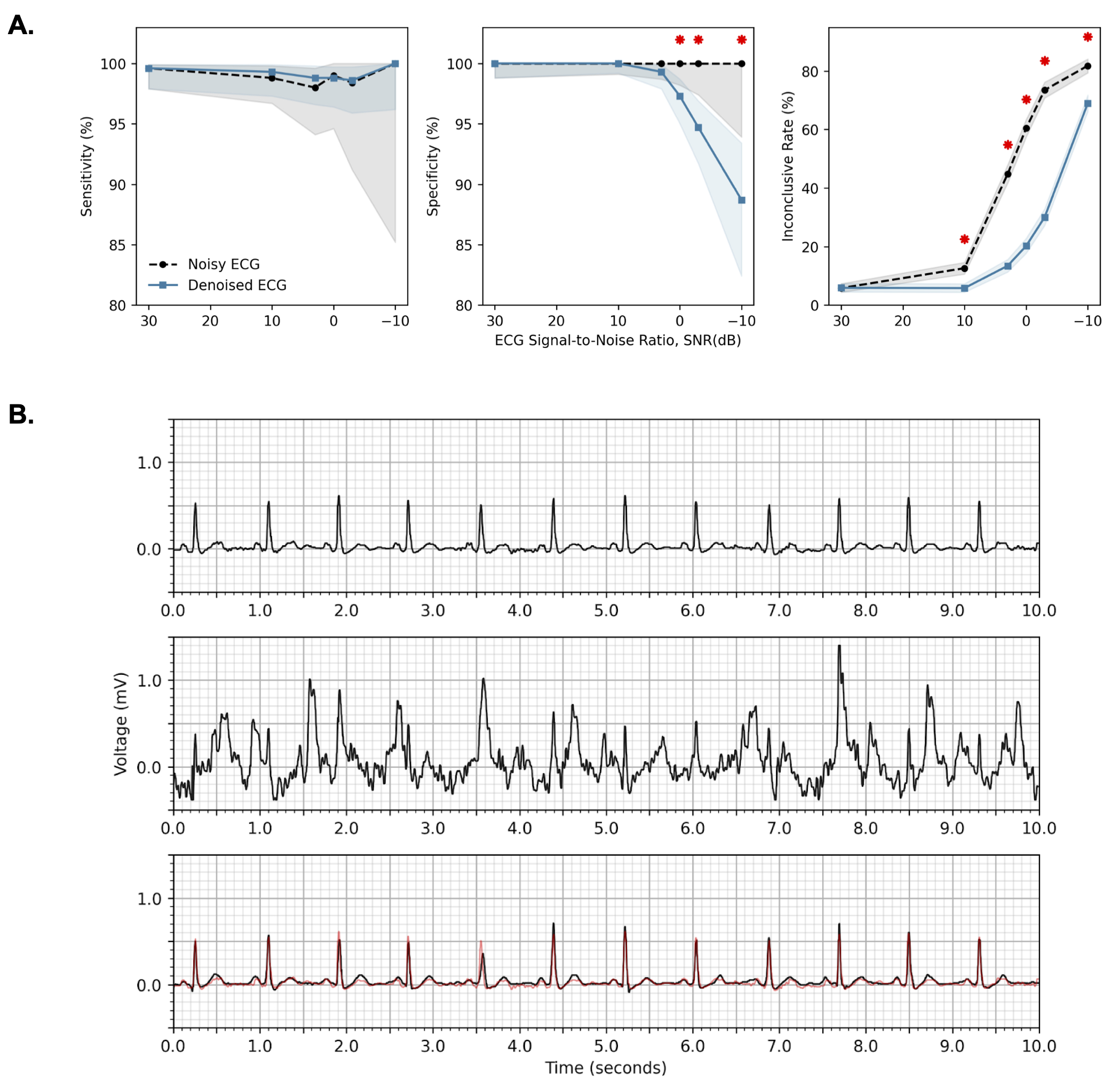Final ID: MDP1536
AI-Based ECG Denoising Improves Smartwatch ECG Interpretation
Abstract Body (Do not enter title and authors here): Background/Aim: Smartwatch ECGs (SW-ECG) have emerged as a noninvasive solution to assess abnormal heart rhythms such as atrial fibrillation (AF). However, SW-ECGs recorded in free-living settings are often noisy and yield Inconclusive results from automated AF detection algorithms. We developed a deep learning model to denoise single-lead ECGs and reduce the number of inconclusive tracings that require manual overread.
Methods: Using the MIMIC-III waveform database (N=2,988 patients, 10.1% AF), we created pairs of clean (high signal quality index based on dynamic beat template matching) 30-sec, single-lead ECGs and their noisy counterparts by injecting various combinations of noise including baseline wander, electrode motion and synthetic noise of different colors. The noisy ECGs served as the input to a 1D U-Net that was trained to reconstruct the corresponding clean ECG (AI-ECG-Denoise). We evaluated the performance of an offline automated ECG classifier before and after applying AI-ECG-Denoise on a held-out test set from MIMIC-III (N=34 patients, 52.9% AF) comprising 1,000 single-lead ECGs that we injected with noise at different signal-to-noise ratios (SNRs), and an external test set of 701 free-living SW-ECGs from 115 healthy consented study subjects using a prototype watch.
Results: In the MIMIC-III test set, AI-ECG-Denoise significantly reduced the number of Inconclusive ECG results across noisy ECGs with SNRs ranging from -10 to 30 dB with no significant difference in sensitivity and specificity for AF down to an SNR of 3 dB. In the external wrist-worn test set, AI-ECG-Denoise significantly reduced the number of Inconclusive free-living SW-ECG Interpretations (p<0.001) by 33.3% [95% CI: 25.1, 39.9], recategorizing the majority as Normal, with no significant difference in specificity per McNemar’s test (99.2% [98.4, 99.8] before and 98.8% [97.8, 99.6] after denoising).
Conclusion: A deep learning model for ECG denoising decreased the number of Inconclusive results in the detection of AF from SW-ECGs. This could help reduce user anxiety and limit the overreading time spent by the physicians.
Methods: Using the MIMIC-III waveform database (N=2,988 patients, 10.1% AF), we created pairs of clean (high signal quality index based on dynamic beat template matching) 30-sec, single-lead ECGs and their noisy counterparts by injecting various combinations of noise including baseline wander, electrode motion and synthetic noise of different colors. The noisy ECGs served as the input to a 1D U-Net that was trained to reconstruct the corresponding clean ECG (AI-ECG-Denoise). We evaluated the performance of an offline automated ECG classifier before and after applying AI-ECG-Denoise on a held-out test set from MIMIC-III (N=34 patients, 52.9% AF) comprising 1,000 single-lead ECGs that we injected with noise at different signal-to-noise ratios (SNRs), and an external test set of 701 free-living SW-ECGs from 115 healthy consented study subjects using a prototype watch.
Results: In the MIMIC-III test set, AI-ECG-Denoise significantly reduced the number of Inconclusive ECG results across noisy ECGs with SNRs ranging from -10 to 30 dB with no significant difference in sensitivity and specificity for AF down to an SNR of 3 dB. In the external wrist-worn test set, AI-ECG-Denoise significantly reduced the number of Inconclusive free-living SW-ECG Interpretations (p<0.001) by 33.3% [95% CI: 25.1, 39.9], recategorizing the majority as Normal, with no significant difference in specificity per McNemar’s test (99.2% [98.4, 99.8] before and 98.8% [97.8, 99.6] after denoising).
Conclusion: A deep learning model for ECG denoising decreased the number of Inconclusive results in the detection of AF from SW-ECGs. This could help reduce user anxiety and limit the overreading time spent by the physicians.
More abstracts on this topic:
A ChatGLM-based stroke diagnosis and prediction tool
Song Xiaowei, Wang Jiayi, Ma Weizhi, Wu Jian, Wang Yueming, Gao Ceshu, Wei Chenming, Pi Jingtao
1-Year Outcomes After Cardioversion With and Without Anticoagulation in Patients With Left Atrial Appendage Occlusion: A Propensity-Matched AnalysisThangjui Sittinun, Trongtorsak Angkawipa, Kewcharoen Jakrin, Thyagaturu Harshith, Watson Hangyu, Mensah Samuel, Balla Sudarshan, Navaravong Leenhapong

